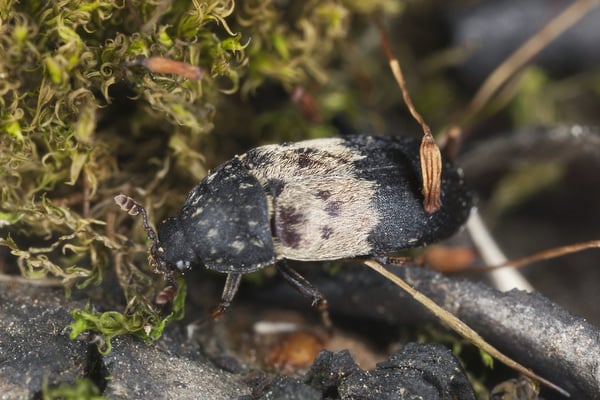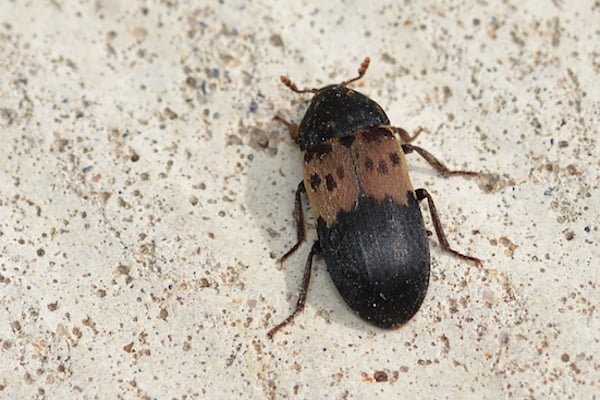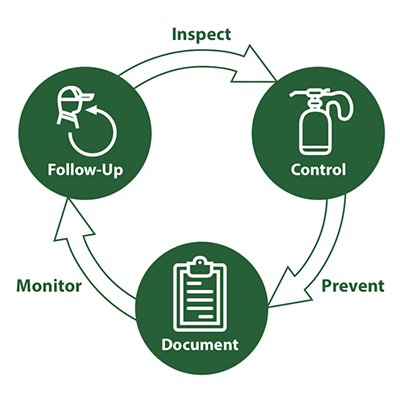Larder Beetle
Appearance And Behavior
Larder beetles (Dermestes lardarius) are a common stored product pest that are found all over the world. The name “larder beetle” refers to the fact that these beetles commonly infest cured meats and other stored provisions.
Adult larder beetles measure ¼ to ⅜” and are oval-shaped. Their bodies are dark brown to black with a large pale yellow or beige band on their wings. There are usually six distinctive black spots dotted across this yellow band. The underside of the beetle is covered in fine, small yellow hair.
Larvae are ⅜ to ⅝” long, dark brown, and covered with long brown hairs. Larvae have 3 pairs of short legs and a pair of small spines (urogomphi) that curve back from their rear. Larva bodies appear to have distinct body segments.
Larder beetles typically complete their full life cycle in 60 to 70 days. They spend the majority of this time as larvae, feeding on nearby dry goods or burrowing into materials. Like many other pests, the speed of the larder beetle’s life cycle depends on the temperature of their environment. Larder beetles grow and reproduce faster in warm, dry environments.
Female larder beetles lay 100 to 800 eggs on or near good food sources. These eggs usually hatch within 12 days. Larder beetles usually only produce eggs once a year, but in favorable environments they may reproduce more frequently. Larvae continuously feeds on nearby food for around 19 days, and they undergo six or seven growth instars. After they grow enough, larvae pupate for around five days. When they emerge as adults, they go looking for mates and good places to lay eggs.

Larder beetle adults and larvae feed on all kinds of animal products including dried fish, ham, bacon, meats, cheese, and pet food. They may also occasionally feed on plant materials such as stored tobacco.
The beetle larvae inflict the most damage. Not only do they feed on stored food material, they may also burrow into hard materials nearby. Larder beetle larvae often burrow into wood, corkboard, or other hard materials in order to pupate in safety. Beetle adults don’t burrow, but they will feed on stored material. Both larvae and adults leave behind waste and shed skin frequently.
Larder Beetle Prevention

The key to controlling larder beetles is to find the primary source of infestation and eliminate it. Thoroughly inspect all the food larder beetles may infest, and the area where you keep that food. Dispose of infested food outside your home.
Thoroughly clean out your pantries, cabinets, and other areas where you kept the infested food. Use a vacuum cleaner with a hose attachment to remove beetles, larvae, dead skin, and waste. Be sure to throw out the bag after you vacuum them up.
Larder Beetle Control Process
First, your Plunkett’s pest management professional will locate areas where larder beetles breed. We’ll clean those areas out and help you figure out how to make them inaccessible in the future. We’ll also look for the access points larder beetles used to get in your home in the first place.
In some circumstances, we’ll use insecticide dust or spray on cracks, crevices, infected structural voids, and other at-risk areas. These insecticides, along with applications of residual insecticide aerosol, will help keep beetles from coming back into your home. Under some circumstances, we may also use insecticides to help preventing breeding.
If you think you have a larder beetle infestation, don’t hesitate to call Plunkett’s Pest Control right away. We’ll find your larder beetles, wipe them out, and help make sure they can’t get in again.

Larder Beetle Control With Plunkett's
At Plunkett’s, our goal is to help you quickly, conveniently, and in the most cost-effective way. We make every effort to be with you asap, usually within a day or two.
Learn More
There are a good number of stored product pests that are particularly likely to make pests of themselves around your home. Some of the most common examples of stored product pests Plunkett’s encounters frequently include:






